Antinol® Latest Studies
Sorted by recent
 Filter Studies by Smart Tags
Filter Studies by Smart Tags
Bone & JointCardiovascularCase Study & ProceedingCatDogEAB 277™EfficacyExotic PetImmunologyNeuro & BehaviorOphthalmologyOralRabbitRenalRespiratoryRodentSafetySkinUTI
Smart Search
Effects of PCSO-524® (Antinol®) Supplementation during 12 Months Follow-up in 2 Cats with Cystitis and Chronic Renal Disease

Two female cats, spayed, lived in the same house, aged 17 years weighted 2.2 kg and 10 years 4.4 kg, were having chronic renal failure and concurrent cystitis.
Both cats were treated with fluid therapy intravenously in the early period and later subcutaneously. The diet was changed to diet formulated for cats with renal failure (Hill’s Prescription diet k/d) for both cats. Avastamine (RenAvastTM) 1 capsule bid for 1 month, Cystaid® cat (Acetyl 0-Glucosamine: NAG125 mg) l capsule bid for 1 month, and PCSO-524® (Vetz Petz Antinol®) 1 capsule sid continuously were prescribed for the first cat. The second cat received only PCSO-524® (Vetz Petz Antinol®) 1 capsule sid continuously.
The treatment results showed general health improvement, weight gain (2.6 kg and 5.1 kg in the first and second cat, respectively), less hair loss, decreased degree of polydipsia and polyuria, and improvement of blood parameters.
No adverse effect of the continuous treatment was found after 18 and 13 months in the first and second cat, respectively.


A Study of Efficacy and Safety
of PCSO-524® (Antinol®) in Treatment of Medial Patellar Luxation and Cranial Cruciate Ligament Rupture in a Yorkshire Terrier Dog

Male Yorkshire terrier dog aged 7 years weight 2.5 kg suffered from lameness of left Hind limb.
Examination found medial patellar luxation of grade 3 and chronic cranial cruciate ligament rupture.
PCSO-524® (Antinol®) 100 mg per day, double size of recommended dose for dogs weighed less than 20kg, was prescribed.
Examination of lameness score and pain on palpation showed improvement after PCSO-524® (Antinol®) treatment. Radiographic images taken before and after 45 days treatment with PCSO-524® (Antinol®) did not find progress of the lesion.
Hematological and biochemistry parameters after 45 days treatment with PCSO-524® (Antinol®) indicated that the medication was safe to use.
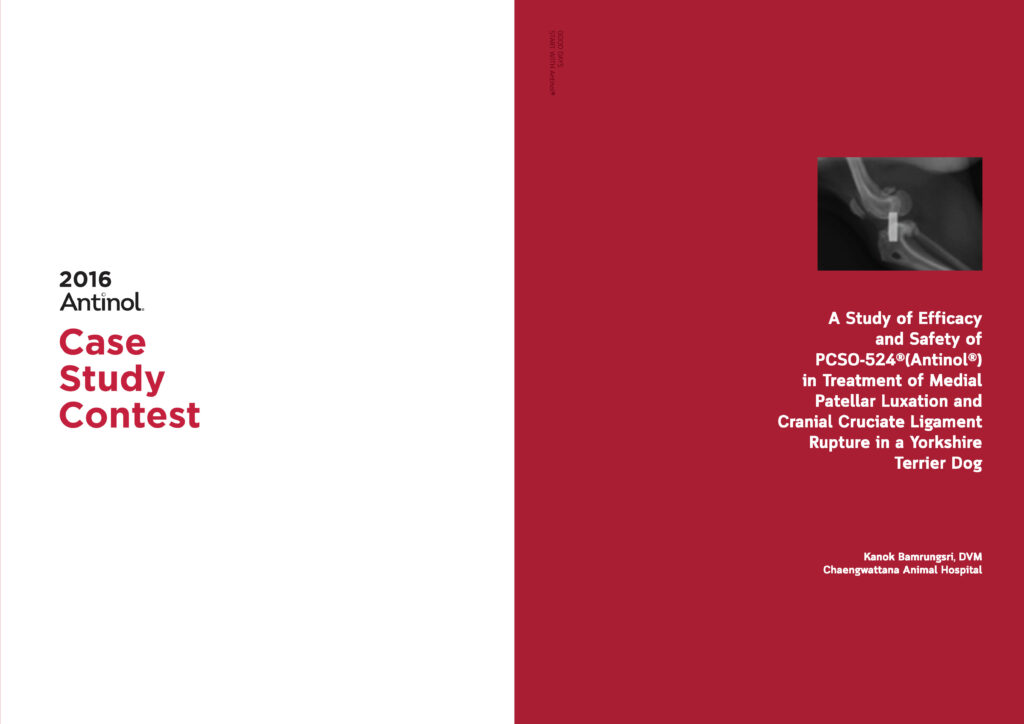
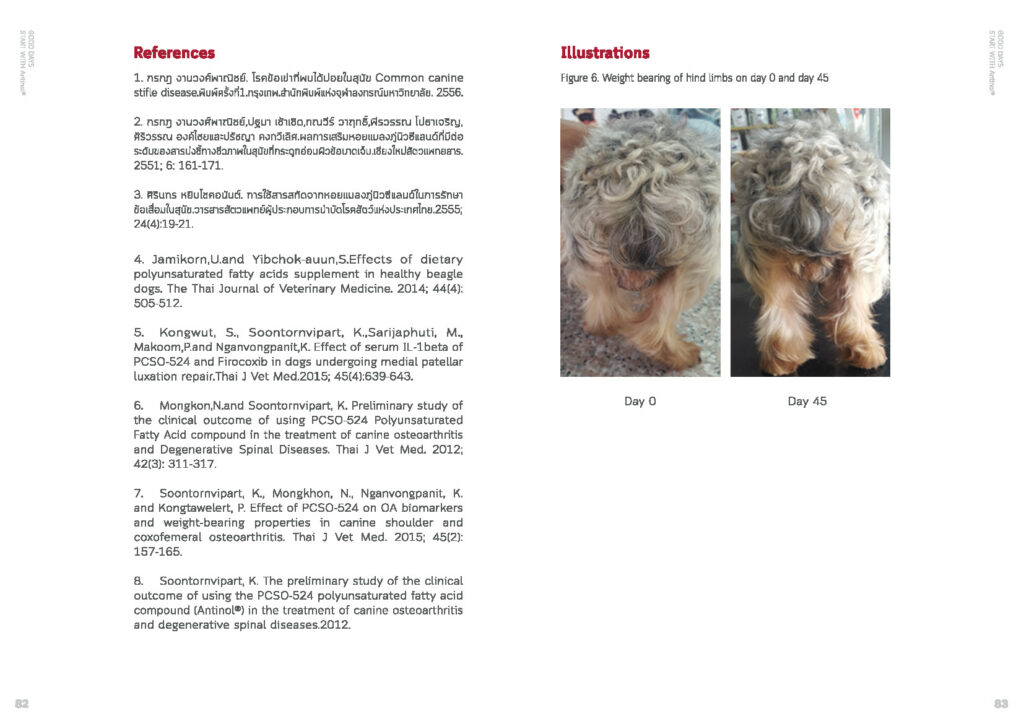
The Treatment of Medial Coronoid Disease in a Seven Months Old Labrador Retriever

Labrador retriever dog aged 7 months with history of right forelimb pain for 1 month was diagnosed as Medial Coronoid Disease (MCD) on both sides.
Radiographic and Computed Tomography (CT) examinations found subtrochlear sclerosis on left elbow. Arthrotomy was operated on the dog using subtotal coronoid ostectomy technique on the medial side of both elbows. Long-term treatment included physical rehabilitation, and nutrition therapy including administration of PCSO-524® and glucosamine/chondroitin sulfate. The dog was followed-up for 6 months for orthopedic examination and assessment by force plate gait analysis.
Two months after the operation, right forelimb could bear body weight, however left forelimb was still lame with lameness score of 1/4. Comparison of radiographic image showed that the left and right elbow was affected from moderate and mild osteoarthritis, respectively. Treatment success for MCD depends on early and accurate detection of the disease and appropriate treatment plan.
Multimodal plan consisting of surgical treatment, medication, nutrition therapy and physical rehabilitation, is proposed.
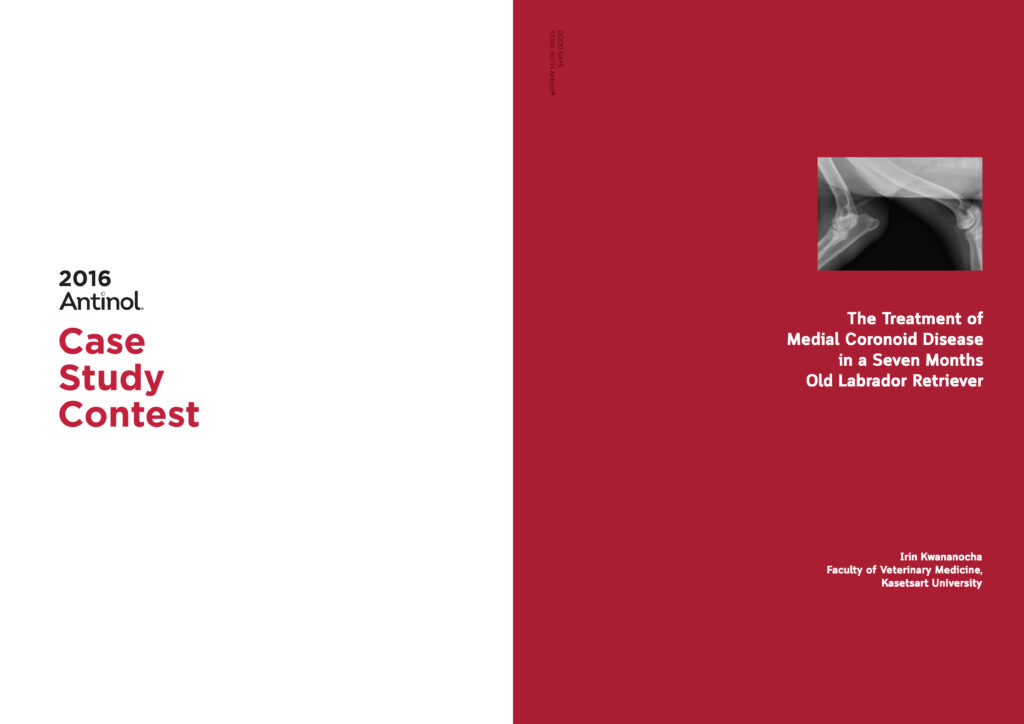

Effects of PCSO-524® on Treatment of Cranial Cruciate Ligament Rupture in Dogs after Tibial Plateau Leveling Osteotomy (TPLO) and Physical Rehabilitation

Male Labrador Retriever dog aged 3 years was suffering from left hind limb pain.
Hematological parameters were normal. Radiographic image showed swollen left stifle joint and mild osteoarthritis. Cranial cruciate ligament rupture was diagnosed.
Firocoxib 5 mg/kg sid for 2 weeks and 2 capsules of ANTINOL ® bid for 1 month were prescribed.
Tibial Plateau Leveling Osteotomy (TPLO) was operated on the dog. Post operation care included Firocoxib 5 mg/kg sid for 2 weeks and 2 capsules of ANTINOL ® bid in combination with physical rehabilitation using laser stimulation and later exercise therapy was added. Clinical signs were improved as indicated by lameness score, muscle mass and range of motion.
Five months after the operation, the dog expressed signs of right hind limb pain and radiographic image showed swollen right stifle joint and mild osteoarthritis of left stifle joint. Partial tear of cranial cruciate ligament was diagnosed. The dog was treated for thrombocytopenia until recovered before Tibial Plateau Leveling Osteotomy (TPLO) was operated on the right knee 3 months later. Radiographic examination post operation showed increased inflammation of both stifle joints.
Surgical treatment was used in combination with medication which included NSAIDs during the first 2 weeks post operation, ANTINOL®, and physical rehabilitation in order to reduce pain and inflammation. The treatment gave satisfactory results. The dog was able to use its legs without lameness, muscle was stronger, stifle angle was better and general health was improved.

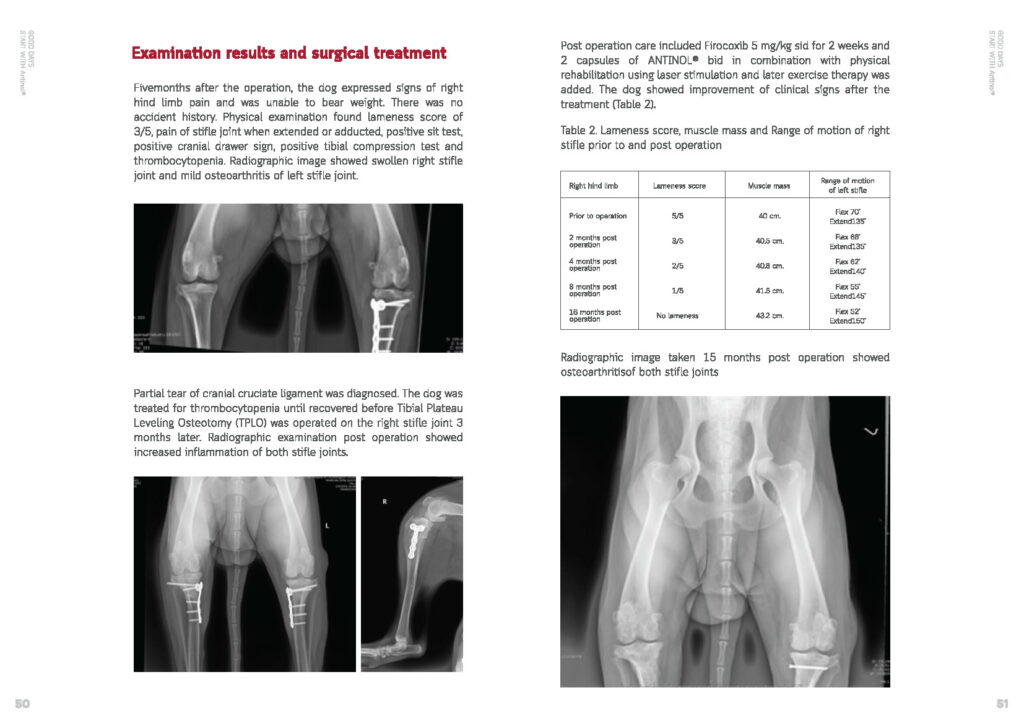
Use of PCSO-524® in Combination with Prednisolone for Treatment of Spinal Cord Injury from Disc Protrusion in Dogs

Male Shih tzu dog aged 9 years and 1 month was diagnosed with limb paralysis after jumping 4 days prior to the hospital visit.
The dog showed weak response of forelimb reflex and severe neck pain. X-ray examination showed block vertebrae at C3 and C4.
Magnetic resonance imaging (MRI) examination found mild disc protrusion, compression on spinal cord and myelopathy at C4 and C5 with compression on the right dorsal lamina.
Prednisolone and gabapentin were prescribed to reduce inflammation and pain, respectively.
Follow-up after reduction of prednisolone showed that the dog fell more often while walking and slight neck pain was present. Prednisolone dosage was then increased and PCSO-524® was prescribed to reduce inflammation of the spinal cord. Later examination found that the dog could walk without falling, both forelimbs showed normal reflex, and signs of neck pain disappeared. Termination of prednisolone was then started without any recurrent clinical signs.
After continuous treatment with PCSO-524® for 6 weeks, the dog could walk normally, both forelimbs showed normal reflex, and the ALK level was nearly back to the level prior to the treatment.
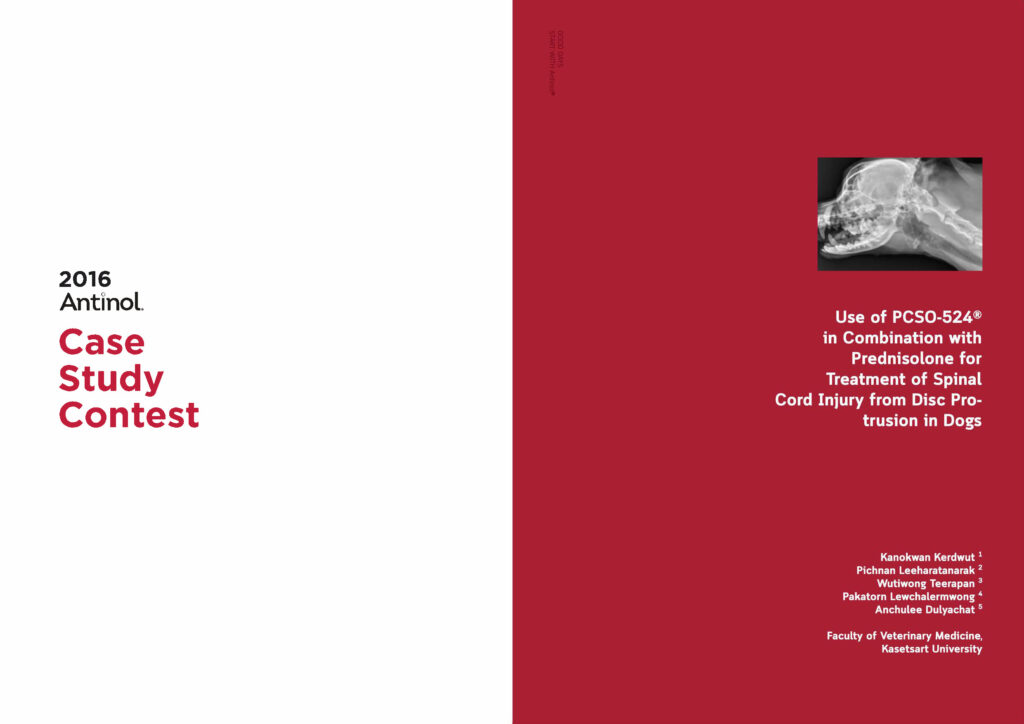
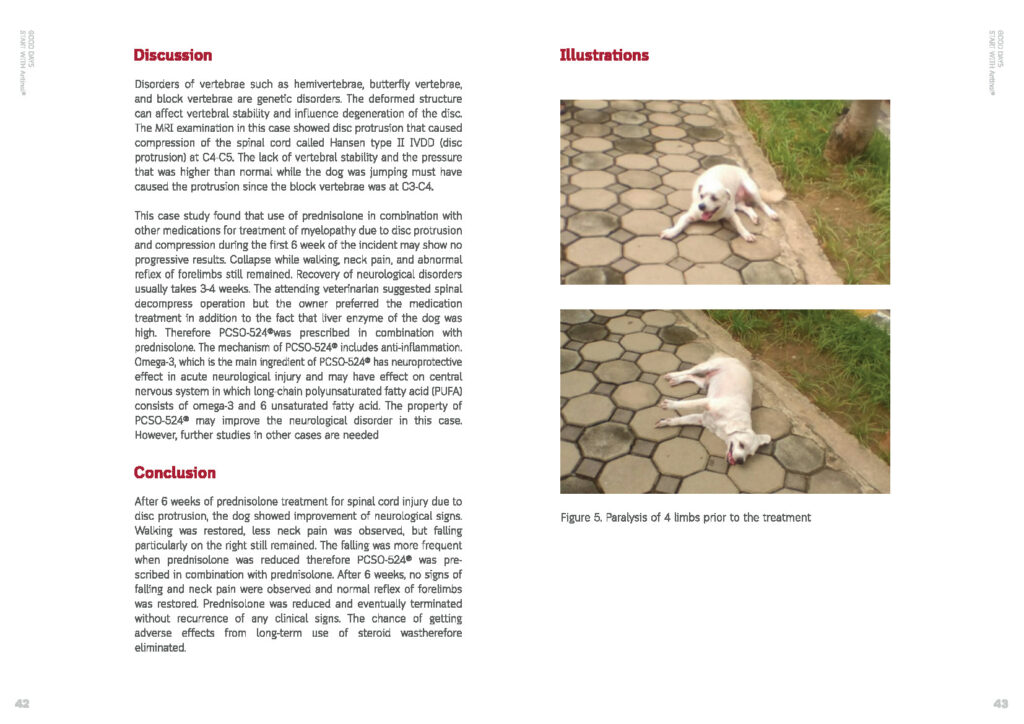
Effects of PCSO-524® on Inflammation Control in Cats with Chronic Renal Disease after Keratectomy and Conjunctival Pedicle Graft for Treatment of Corneal Sequestrum from Indolent Ulcer

A female spayed cat aged 13 years with chronic renal disease later affected with indolent ulcer, and consequently followed by corneal sequestrum.
After azotemia was controlled, the cat was surgically treated with keratectomy that used conjunctival pedicle graft for suture closure.
The cat received 4mg/kg Tolfenamic acid (Tolfedine®, Vetoquinol, Best Agro; Thailand) for 3 days, 2.5 mg/kg Doxycycline monohydrate (Vibravet®, Zoetis, Thailand) for 2 weeks and 1 tablet per day of New Zealand Green-lipped mussel extract, PCSO-524® (Vetz Petz Antinol®, DKSH, Thailand) for long-term control of inflammation.
The latter was used as an antioxidant and alternative to Non-steroid, which is a contradiction for chronic renal failure.
The cat showed decreased severity of inflammation, normal clinical symptoms, and fine control of azotemia.
It is concluded that PCSO-524® (Vetz Petz Antinol®) can be used to support long-term anti-inflammation treatment and reduce the damage in cats with medical contraindication due to chronic renal disease

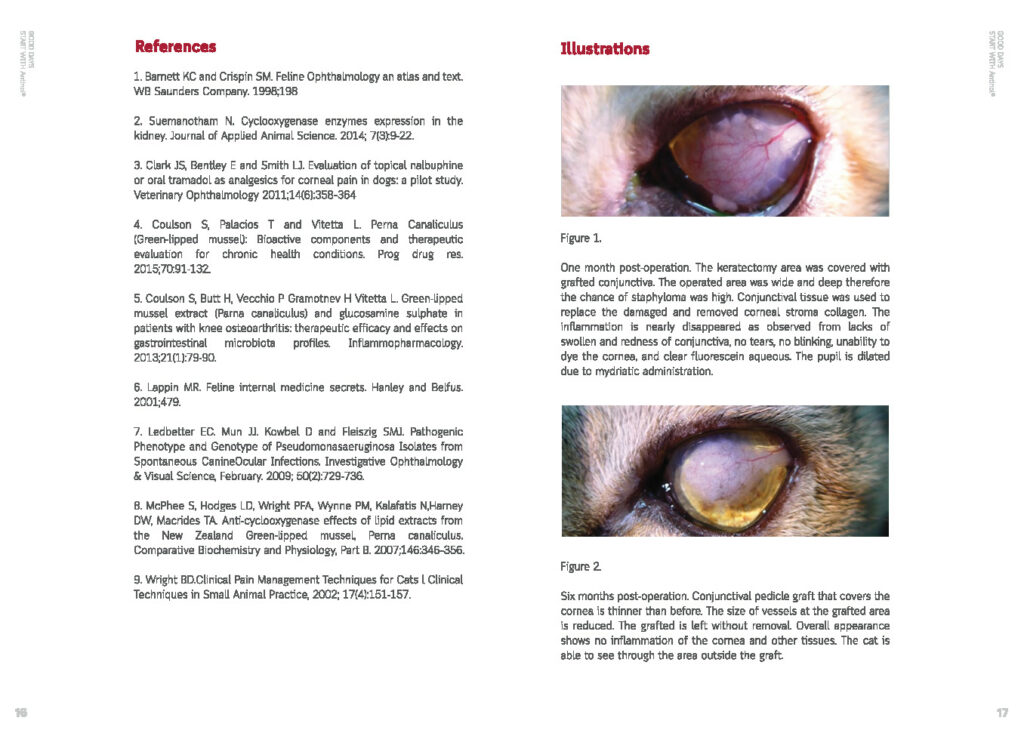
Effectiveness of Disease Modifying Osteoarthritis Agents and Carprofen for Treatment of Canine Osteoarthritis

A prospective, randomized, single-blinded study was conducted to evaluate and compare the effectiveness of disease modifying osteoarthritis agents (DMOAAs) and carprofen by using force plate gait analysis and orthopaedic assessment score (OAS) in osteoarthritic dogs.
Forty dogs with hip and/or stifle osteoarthritis (OA) were assigned randomly into four treatment groups:
PCSO-524, treated with a marine-based fatty-acid compound; GC-ASU, treated with a combination of glucosamine-chondroitin sulphate and avocado/soybean unsaponifiables; CPF, treated with carprofen; and CPF-PCSO, treated with a combination of carprofen and PCSO-524. Each group received the therapeutic agent orally for four weeks.
Peak vertical force (PVF), OAS, haematology and blood chemistry values were evaluated before treatment, and on the second and fourth weeks post-treatment.
No significant effect was found in the PVF, OAS and blood values among the four treatment groups.


Effect of PCSO-524 on OA Biomarkers and Weight Bearing Properties in Canine Shoulder and Coxofemeral Osteoarthritis

This trial included 66 mixed breed dogs with x-ray confirmed OA split into two treatment groups for 24 weeks. These were 1) PCSO-524 (5 mg/kg) and 2) fish oil (2,000 mg/d). The dogs were all placed on a standardised diet to minimise variability.
The results suggest that PCSO-524 is protective against cartilage breakdown in dogs with osteoarthritis.


The Effectiveness of Marine Based Fatty Acid Compound and NSAIDs for the Treatment of Canine Osteoarthritis: a preliminary study

The Objectives of this study were to investigate the effectiveness of PCSO-524, NSAIDs and combination of NSAIDs and PCSO-524 in the treatment of canine osteoarthritis through the use of force plate gait analysis.
Study Design: A prospective block-randomized single-blinded study.
Animals: Thirty client-owned dogs that had clinical and radiographic evidences of hip or stifle osteoarthritis.

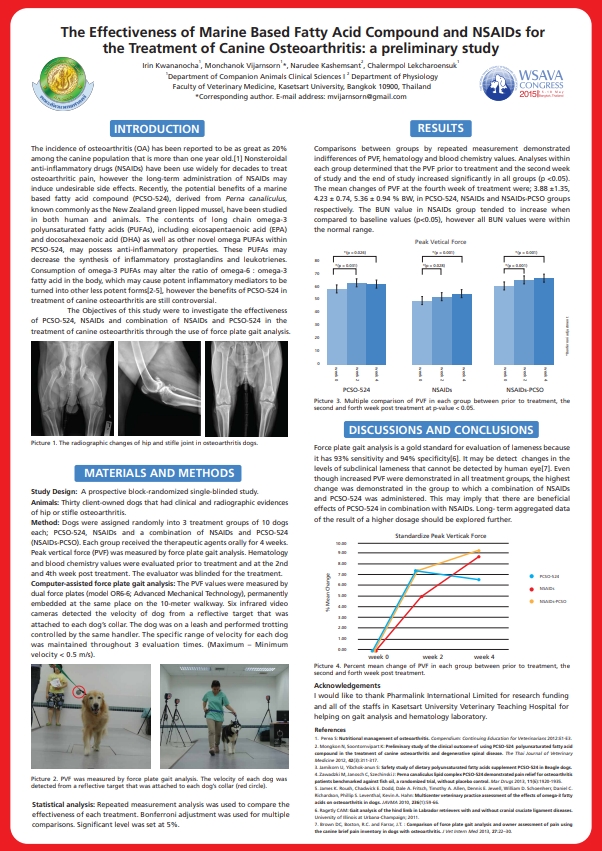

Effects of Dietary Polyunsaturated Fatty Acid Supplement on Healthy Beagle Dogs

A randomized complete blocked design was assigned to 40 healthy Beagle dogs aged between 1 to 3 years old. All dogs were separated into 4 groups, each of which had 5 males and 5 females.
Adaptation and test periods were of 2 and 8 weeks duration, respectively.
Four dietary treatments were composed of basal diet plus 20 empty capsules as placebo (negative control), basal diet plus 2 (the recommended dose), 6 (3 times the recommended dose) and 20 capsules (10 times the recommended dose) of n-3 PUFAs (PCSO-524®: Antinol®).


Updated Study Topics
New researches and publications related to PCSO-524® and its result in clnical test submitted by veterinarians on the global conferences every year and the data keeps growing with more studies conducted


 Authors:
Authors: